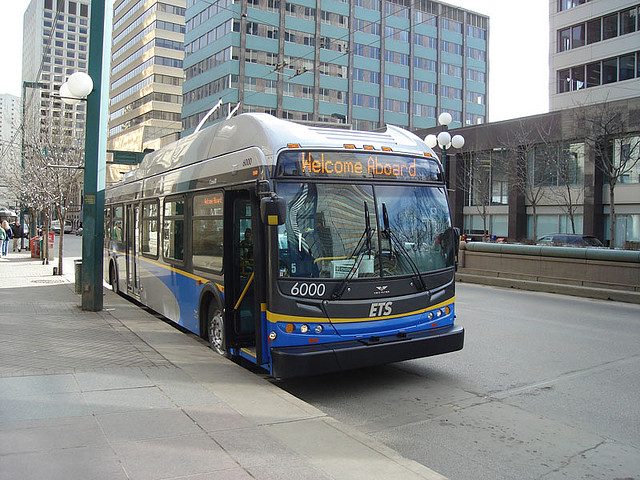In accordance with Edmonton’s 2013 operating budget, Edmonton Transit System’s (ETS) cash fare jumped $.20 on Friday, February 1. The fare hike also raised pre-purchased ticket and monthly pass prices, affecting all ETS riders, including seniors, youth, students and adults. For Edmontonians who only occasionally use the city’s transit system, this increase in price might seem slight. But for patrons who rely on the ETS to get to and from work, school, and community events, the fare hike gives rise to some concerns. The lack of any recognizable operational changes can only lead riders to conclude that this fundamental public service is providing revenue for the city. This increase in transit fare thus suggests that the city is gaining revenue from its public transit system in order to fund other services and projects.
[related_content slugs=”the-walterdale-bridge-a-makeshift-memorial-to-edmontons-colonial-past,corporate-influence-and-aboriginal-consent-in-alberta-bill-c-45,full-time-kindergarten-in-alberta-is-a-womens-issue” description=”More from Cynthia Spring” position=”right”]
Although the city’s operating budget has not prioritized public transportation funding, city council has approved the Oilers’ new downtown arena. The arena is part of a larger proposal to revitalize Edmonton’s downtown core. The $601-million deal includes a public rink, a traffic overpass, and a plaza of shops called “Winter Garden.” But the bulk of the project’s budget is going toward the private hockey club’s $480-million stadium. Coinciding with the ETS fare hike, Edmonton’s investment in this project indicates that the city has disregarded its low-income residents for the sake of private corporate gains.
The ETS’s single cash fare has increased by $.45 over the past two years. The culmination of these incremental fare hikes most directly affects those who are unable to afford alternative modes of transportation. When half of the ETS’s ridership is earning less than $50, 000 a year as a family home, increases in fares create difficulties for riders whose livelihood or education depends on this service. As transit becomes increasingly unaffordable, Edmonton’s low and modest income families and individuals will only face further economic challenges. With the continuous hiking of prices, it seems that the city has forgotten that public transit is an essential service within a sprawling city like Edmonton.
Just weeks prior to the implementation of this fare hike, the city agreed to help finance the Oilers’ new arena. Daryl Katz, owner of the Edmonton Oilers, has marketed the new arena as a revitalization project that will boost economic development in Edmonton’s downtown core. Sure enough, the $125-million in municipal funding promised to the Oilers will be raised, the city says, by a “community revitalization levy.” Instead of imposing higher property taxes directly, the city is expecting that development in the northern downtown area will increase property value and, in turn, taxes will be levied. There will also be a ticket surcharge that will fund the principal and interest payments for repayment of the $125-million over the course of 35 years. According to this fundraising and repayment plan, the arena will eventually pay for itself through commercial and residential development.
Despite these optimistic predications, it is difficult to accurately predict how successful a revitalization project will actually be. Many critics of the new arena are concerned that because the project has not secured an expected $114-million in provincial funding and has failed to address the possibility of going over budget, the city is gambling with taxpayer money. And when 80% of regular season ticket sales come from within the community, it is important to acknowledge that although establishments surrounding a sports stadium might prosper, other entertainment venues and commercial areas will likely suffer. That is to say, if the Oilers’ revenue is coming from within the community, an increase in ticket sales only relocates community spending. The benefits of the arena, then, seem limited to the private team and the surrounding downtown businesses.
While these two municipal issues—the approval of the new Oilers’ arena and the implementation of the transit fare increase—are not dependent on each other, both are dependent on public funding. If the city of Edmonton can afford to replace Rexall Place with an elaborate new arena and development plan why can’t it afford to freeze public transit prices? Both funding decisions point to a discrepancy between the city’s investment in private corporate development and its disregard for public services. During a meeting with representatives for the Oilers and city council on January 23rd, Edmonton mayor Stephen Mandel said the city owes its citizens a new NHL arena. But Mandel also confirmed that it was in his best interest that the Oilers prosper and said that the city wants the Oilers to “make a bucketful.” All this suggests that the new Oilers arena only protects certain stakeholders, namely Katz and the Edmonton Oilers. By funding this private endeavor and neglecting an essential public service, the city has both contributed to and exposed the larger social issue of economic disparity in Edmonton.
—
Cynthia Spring is a writer living in Edmonton.
Follow us on Twitter @SpectatorTrib
